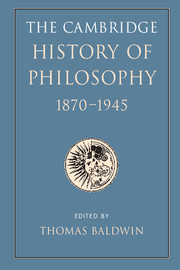Book contents
- Frontmatter
- Contents
- List of contributors
- Introduction
- I 1870–1914
- II 1914–1945
- 8 Logic and philosophy: the analytic programme
- 9 The diversity of philosophy
- 10 Knowledge, language, and the end of metaphysics
- 11 Philosophy and the exact sciences
- 46 First-order logic and its rivals
- 47 The golden age of mathematical logic
- 48 General relativity
- 49 Scientific explanation
- 50 The rise of probabilistic thinking
- 12 Mind and its place in nature
- 13 Philosophy and social science
- 14 Ethics, religion, and the arts
- 15 Law and politics
- Biobibliographical appendix
- Bibliography
- INDEX
- References
49 - Scientific explanation
from 11 - Philosophy and the exact sciences
Published online by Cambridge University Press: 28 March 2008
- Frontmatter
- Contents
- List of contributors
- Introduction
- I 1870–1914
- II 1914–1945
- 8 Logic and philosophy: the analytic programme
- 9 The diversity of philosophy
- 10 Knowledge, language, and the end of metaphysics
- 11 Philosophy and the exact sciences
- 46 First-order logic and its rivals
- 47 The golden age of mathematical logic
- 48 General relativity
- 49 Scientific explanation
- 50 The rise of probabilistic thinking
- 12 Mind and its place in nature
- 13 Philosophy and social science
- 14 Ethics, religion, and the arts
- 15 Law and politics
- Biobibliographical appendix
- Bibliography
- INDEX
- References
Summary
INTRODUCTION
The great French philosopher-historian of science Emile Meyerson (1859–1933) began his 1929 Encyclopedia Britannica article ‘Explanation’ with the following words:
What is meant by explaining a phenomenon? There is no need to insist on the importance of this question. It is obvious that the entire structure of science will necessarily depend upon the reply given. (Meyerson 1929: 984)
Meyerson’s conclusion would be difficult to overstate: the structure of any given science — indeed, of science itself — is developed around the ideal of explanation peculiar to it. Explanations in physics differ formally and materially from those in biology; and both differ from explanations provided by geologists and sociologists; even more generally, explanations in science differ widely from those given in, say, law or religion.
MEYERSON ON THE TWO MODES OF EXPLANATION
From the publication of the 1908 first edition (of three) of his monumental Identité et Realité (Identity and Reality) until his death in 1933, Emile Meyerson was not only France’s dominant philosopher of science, he was one of the most important philosophers of science throughout the Western world. In the opening chapter of Identity and Reality, Meyerson speaks of two sharply opposed modes of explanation: the ‘mode of law’, and the ‘mode of cause’. Each mode has ancient philosophical roots. Law-explanations may with some justice be traced to Heraclitus’s dictum that everything changes except the law of change itself. Cause–explanations, according to Meyerson, trace back through atomic theory all the way to Parmenides’s notion of the unchanging self-identity of being.
- Type
- Chapter
- Information
- The Cambridge History of Philosophy 1870–1945 , pp. 608 - 620Publisher: Cambridge University PressPrint publication year: 2003
References
- 1
- Cited by



